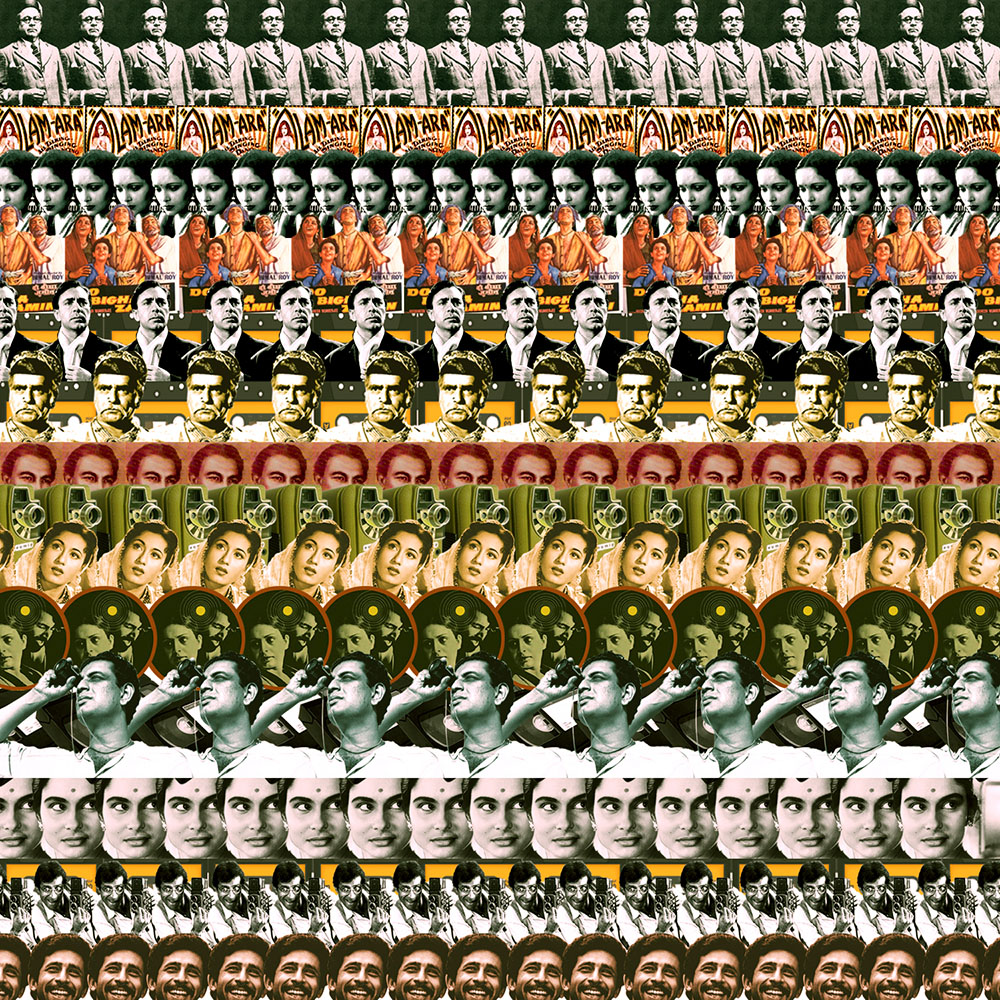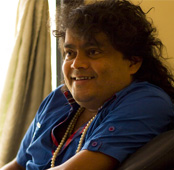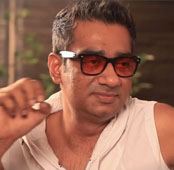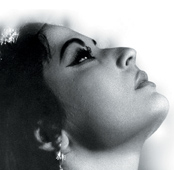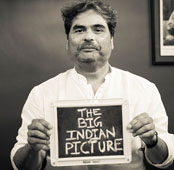-
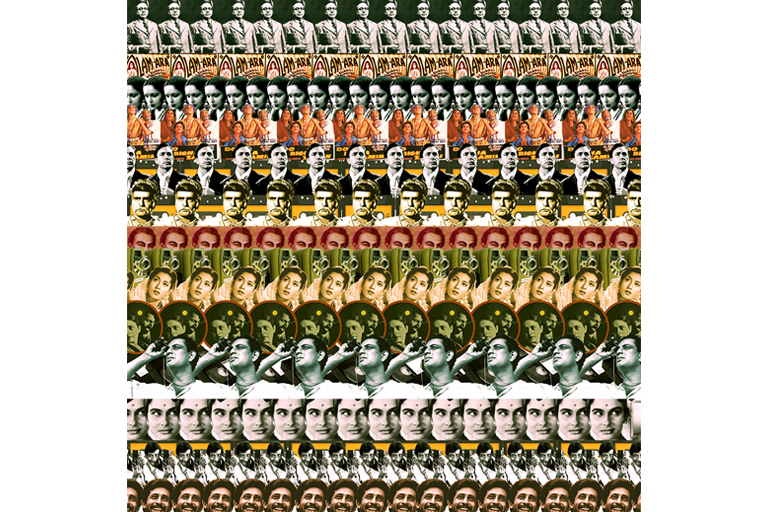 Amrita Bagchi for TBIP
Amrita Bagchi for TBIP
Filmmaker Shyam Benegal’s lecture on a hundred years of Indian Cinema delivered at Victoria Memorial, Kolkata
The Beginning
When cinema was brought to India three years after its invention, in 1896, for a demonstration at the Watson’s hotel in Bombay, no one would have predicted that within a period of 75 years India would become the largest film producer in the world with films regularly made in over 22 languages every year. Soon after its first demonstration, several technologically minded Indians were already tinkering with film cameras of the time. The first known film was actually a filmstrip shot in 1901 which showed a mathematician, Wrangler Paranjpe, coming down the gangway of a ship at Bombay’s Apollo Bunder. From the novelty of recording live moving images on film to using film technology to tell stories and complex narratives was a fairly short step.
Among the pioneers were a number of theatre entrepreneurs both in Bombay and Calcutta who attempted to make films specially for Indian audiences. Eventually it was Dadasaheb Phalke who preceded all others with Raja Harishchandra which he released in 1913.
Barely a year after Raja Harishchandra was released, Mahatma Gandhi returned to India.
Early 20th century was a period when the nationalist movement gathered steam. The demand for swaraj or self-rule became the anthem. Among the political strategies, and actions that nationalist groups undertook, was to boycott British-made cloth and other goods. Large bonfires would be made of videshi or foreign goods. The word swadeshi gained currency. To rely on oneself and to be self-sufficient, became an integral part of the nationalist agenda. Gandhiji’s political strategy aimed at regaining Indian self-esteem with the privileging of the charkha as the symbol of resistance.
Indian cinema in many ways grew in size and strength much like the freedom movement. Making films indigenously, like the setting up of the steel industry by Jamsetji Tata, could be seen as a nationalist act. When Dadasabeb Phalke chose to make films on mythological subjects, consciously or unconsciously he was asserting the primacy of Indian traditions and culture. Even films that dealt with contemporary and topical subjects, tended to be critical of the slavish adoption of colonial fashions and lifestyles. For instance Dhiren Ganguly’s film Bilat Ferat, or ‘England Returned’, satirized people with westernized tastes. It became the first film to be caught up in colonial censorship. A few years later, Bhalji Pendharkar’s Vande Mataram Ashram was banned, evidently viewed as a threat to the British government. This led to the creation of a censor board for cinema by the colonial government which ironically continues to this day, nearly 66 years after India became independent.
Ideas of social reform influenced by the nationalist movement often found voice in films, both in Bombay and Calcutta. Filmmakers like Baburao Painter in Kolhapur and Pune, and later the legendary V Shantaram who learnt filmmaking from Baburao Painter, made several films that critiqued caste attitudes and adopted reformist views when it came to traditional inequalities in both caste and gender relations. Quite a number of filmmakers chose stories of medieval saints in order to cleanse what they considered were corrupt social practices in contemporary Indian society.
By the time sound came to cinema at the beginning of the 1930s, cinema had established itself as a prime entertainment medium in the major cities of India. Soon it would cover all of urban India.
The Advent of Sound
With sound, came song and dialogue. Both these elements were to become integral to Indian cinema. Alam Ara— the first ‘sound film’ made in 1931, had over 30 songs.
Songs and rhetorical dialogue, which were the staple of successful theatrical productions, were taken wholesale by Indian cinema. This gave it distinct character. It was around the same time that films in regional languages started to be made. Unlike silent films, which could be shown all over the country, regional films could not be shown beyond the regions where the language was spoken. It was also during this time that the freedom movement under the Congress had resolved to make Hindustani the national language of the country. Thus films made in Hindustani could see themselves as ‘all-India films’. To succeed they had to design themselves for pan-Indian appeal.
Strangely enough, Hindustani films were produced in cities such as Bombay and Calcutta where the commonly spoken language was neither Hindi nor Urdu. As a consequence filmmakers had to opt for an idiom that was simple and easily understood across the board. Both these cities had a flourishing theatrical tradition from the mid-19th century that was patronized by the urban elite— the Parsi-Urdu theatre. Combined with local theatrical forms this had become the basis for Indian cinematic form. In Bombay there was a flourishing Gujarati Bhangwadi theatre and the musical Natya theatre in Marathi. Both these forms went on to become models for the unique character that popular Indian cinema would take on.
While mythologicals and costume dramas were easily made with clearly set models from urban and rural theatrical genres, the real problem for Hindustani cinema lay in handling subjects of a contemporary nature. Making a pan-Indian film meant the construction of an environment and a culture that would be acceptable all over the country. Clearly, this invented national culture was a construct that glossed over a great deal of the diversity that was part of India. People were presented in a generalized and eventually standardized way that would not identify them with any recognizable region. They were quite simply urban or rural, rich or poor, or identified by the social class to which they belonged, though admittedly the standard Hindi-Urdu idiom of these films marked them in unacknowledged ways as upper-caste, middle-class, and ‘North Indian’. They only had first names and no surnames. Surnames would give away their caste, community and their regional origin. The only other identification was their religion. Hindustani films represented India in much the same way the nationalist movement did, identified mainly by the two communities, Hindu and Muslim. Regional films, on the other hand, were far more culture specific and rooted in their communities in terms of subjects and their treatment. They could use their local idioms, customs, manners and conventions to make a greater claim on realism. Interestingly, successful regional films would often be remade in Hindustani, after being culturally transformed to make them accessible and acceptable in all parts of the country.
Most Hindustani films that were part of the genre of family socials were domestic melodramas or love stories set in a familial milieu. The stories they told were more like parables rather than realistic narratives. In the pre-independence era a fairly large number of films dealt with socially relevant subjects such as untouchability in Achhut Kannya (Franz Osten, 1936) or the emancipation of women in Duniya Na Mane (V. Shantaram, 1937). In Achhut Kannya for instance, the glamorous Devika Rani played an untouchable girl. However, there was no attempt at credibility or realism in making her look the part. What is more, the film was directed by a German filmmaker, Franz Osten, whose ignorance of Hindustani was only matched by his lack of knowledge of local customs. The theatrical tradition of suspension of disbelief and the disregard for the historical context continues in popular cinema until today. Take a recent film like Black, released a few years ago. The family is identified as being Anglo-Indian because they speak English. Beyond this primary identification everything else is invented. An invented world, an imaginational culture devised by the director. Audiences, however, did not find this unacceptable and the film went on to become a great success. Hindustani films were accepted not because they created a credible milieu, but because they legitimized traditionally accepted social values that extolled the sanctity of the family and its primacy over the individual. Sacrificing oneself for the family—renunciation leading to redemption—were common themes in films of the time. Traditional culture as presented in popular Hindustani cinema was not so much what existed in reality as much as it represented a normative ideal, although reformist ideas would often be introduced in these films unlike in their counterpart, the ‘Muslim socials’.
Often seen as a twin of the Hindu family social (yet not quite a twin), the genre of Muslim socials presented a flattering image of the Muslim community as cultivated and essentially feudal, extolling virtues once again of self-sacrifice, loyalty, friendship and family honour. Hindus and Muslims as either twins or brothers in the family of India would eventually become a recurring motif in several Indian films before and immediately after Indian independence. Films of the period like Padosi (made by V. Shantaram, 1941) and Hamrahi (by Bimal Roy, 1945) echo the theme of twins.
Secularism in Indian Cinema
Interestingly, the separatist politics of the Muslim League never seriously found a voice in the popular cinema, and, indeed, found ideological opposition in the cinema of the forties and fifties. For example, Prithviraj Kapoor’s play Deewar, which was subsequently made into a film by him, represented Partition as a threat to the unity of the family. It is not insignificant that writers and poets belonging to the Progressive Writers Group and the Indian People’s Theatre Association came into the cinema at about that time. Writers like Saadat Hasan Manto, Ali SardarJafri, Rajinder Singh Bedi, Sahir Ludhianvi, Kaifi Azmi, Khwaja Ahmad Abbas and others brought a politically left-wing and overtly secular outlook to the films they were associated with. While most of them remained active in the cinema over the years, their early attempts were largely unsuccessful at the box office because of the radical views they propagated. Popular cinema could not afford to give up the traditional values that were part of its appeal to the mass audience. Thus for example, when the eminent novelist Premchand wrote the script for Mazdoor (made by Mohan Bhavnani in 1934), it sank without a trace. Similarly, Saadat Hasan Manto’s attempts to subvert the Muslim social with films like Najma (Mehboob Khan, 1943) and Naukar (Shaukat Hussain Rizvi, 1943) did not meet with commercial success.
With Partition and Independence, a substantial section of the Muslim population became citizens of Pakistan, and India found itself with an overwhelmingly large majority of Hindus. One significant and far-reaching consequence of the division of the country along religious lines was that there was an increased ambivalence towards the minority Muslim community. Indian Muslims were perceived as continuing to have a choice in the matter of citizenship— they could either remain in India or emigrate to Pakistan. Their allegiance to the country was not taken for granted as easily as it was with the other religious groups; thus their nationalism was always suspect and needed to be ritually reaffirmed or proven. Simultaneously, the protection of minorities, a commitment under the Indian Constitution, became the most important aspect of the newly affirmed secular State. This posed several problems for the Hindi cinema. How were Muslims to be depicted in the Cinema? There was an awkward formality and a great deal of self-censorship in the way they were shown. Part of the problem had to do with political correctness and a desire not to offend— Muslim characters were routinely shown as sane, sensible, good and devout. During the Nehruvian era, many films, especially those that were written by progressive writers, strived to create the image of a secular Muslim. For instance in the 1959 film, Dhool Ka Phool (late Yash Chopra’s first film), an old Muslim adopts an abandoned child whose religious antecedents are not known and sings a song to the boy, which in effect goes, “You will not grow up to be either a Muslim or Hindu; you are the son of man, so a human being you shall be”. There was a great deal of tokenism as well with Muslim characters playing walk-on parts in attempts to represent the diversity of Indian society in cinema. Such sanitized representations were also due, in part, to the constraints of the Government’s Censor Board, which would come down heavily on what it interpreted as negative characterizations of members of any minority community (Christians, on the other hand, were often depicted as good-hearted drunks, presumably because Christianity had no strictures against drinking alcohol).
Communal harmony thus became a kind of signature in a large number of films during the fifties and the sixties. Hindi cinema soon came to be seen as a socially integrating force and the National Awards instituted for films by the Government of India included one that was given for promoting national integration. Interestingly enough, while Hindi films found it difficult to deal with ordinary Hindu-Muslim relationships without sanitizing them, there was no such inhibition in the regional cinemas. In Kerala, where there is a sizeable Muslim and Christian population, inter-communal relationships were depicted in a far more direct and credible way. Ramu Kariat made films like Moodupaadam (1963) and Chemmeen (1965) that centered on inter-communal love stories. This was possible because Kerala had not been affected by the trauma of Partition despite having communal and caste-based parties and associations, and perhaps, also because Malayalam films did not seek to represent themselves as ‘India— the nation’. Muslims in Kerala did not experience the kind of social insecurity and diffidence that sections of the Muslim community felt in northern India after Partition. By contrast, Hindi cinema was self-consciously secular in its attempt to make the minority Muslim community feel accepted and socially secure, yet it often reflected and performed a paternalistic duty of the avowedly secular Indian State towards Muslims. Consequently, benign as it may have appeared, the secularism of the Hindi cinema of this era reflected to a large extent the secularism of the State, which was at best patronizing. This formulaic representation of Muslims and other religious minorities continued through the fifties and the sixties.
It was not until the early seventies that things began to change and Hindi cinema found it possible to tackle subjects related to Partition and the contemporary Muslim experience, which until then were considered awkward subjects liable to inflame communal passions. Two significant developments paved the way for an alternative politics of minoritarian representation: one— the creation of State-established institutions like the Film and Television Institute and the Film Finance Corporation that enabled the emergence of the ‘new cinema’, two— the second partition of the subcontinent in 1971 that led to the creation of Bangladesh.
Let me lay out some of the material conditions that led to the emergence of the new cinema, and then provide a brief survey of some of the more important films that placed minority communities at the center of their narratives. I would also like to examine the significance of the creation of Bangladesh in 1971 and how it made possible the production of films like Garm Hava that treated the subject of Partition in a realistic manner for the first time in Hindi cinema.
To understand the importance of the new cinema, it would be important to situate some of the developments that took place in the cinema of the post-independence period. Indian cinema was already a flourishing industry at the time of independence. It was totally market driven and unregulated. Financial booms and busts were quite frequent. This prompted the Government of India to set up a committee to look into the affairs of the film business. The committee made several far reaching recommendations that would set the course for cinema in the next fifty years. Among the recommendations were the setting up of a fund to finance films, an institution for teaching filmmaking, a children’s film society to encourage filmmakers to make children’s films, the creation of a national film archive, and so on. There were other recommendations too, which were not particularly helpful to the cinema, such as the levy of an entertainment tax on film screenings. Since cinema was not understood to be socially productive by the State, the tax was somewhat punitive in nature. Moreover, since the state governments (not the central government) levied the entertainment tax, it varied from state to state— 55% of the price of a ticket in Maharashtra, going up to 132% in Uttar Pradesh and 146% in Bihar. (The centre is now recommending a 30% Tax across the country). The government, in effect, ended up by earning much more from films than either the film producers, distributors or exhibitors. As a result, the old studio system became unsustainable and gave way to independent entrepreneurs and speculators. Filmmaking became a far more speculative and high-risk business than it had ever been in the past. In spite of this, the film business grew by about eight to 10 percent each year due to the phenomenal growth of cities, towns and new urban townships in the wake of industrialization and other programs of economic development. The complexion of the audience too began to change. The older middle class was no longer the arbiter of taste in the cinema. A growing new middle class, an increasing working class and vast numbers of recent immigrants from the countryside into towns started to play their part in determining the aesthetics of the cinema. Films had to meet their entertainment needs since they constituted the largest segment of the audience. The effect of all this started to be felt in the popular cinema of the sixties. The common denominator of films got lowered, and widened to appeal to the largest number of people. Consequently, there was a growing concern in the State establishment that the increasing number of films being made each year did not indicate any improvement in the quality of cinema. The most frequent criticism was that the popular cinema aped and plagiarized Hollywood films and was not Indian enough. This concern paved the way for State sponsored funding agencies that would help promote a different kind of cinema, one which was not necessarily designed to meet the perceived demands of the marketplace.
By this time Satyajit Ray had arrived on the scene with his highly celebrated cinematic works. His films were not only successful at the box office in his native Bengal but were critically acclaimed all over the world. Ray’s films along with those of his two other contemporaries Ritwik Ghatak and Mrinal Sen were not simply vehicles of mass entertainment. Apart from their artistic qualities, they were seen as closer to Indian reality and life. Ironically, given Ray’s own resolute sense of Bengali identification, for cineastes and critics outside India, Ray’s films represented India. Ray’s cinematic aesthetics thus set the tone for the various institutions that the State established for the cinema. The most significant of these were the Film and Television Institute and the Film Finance Corporation. By the beginning of the 1970s graduates from the Film Institute were making films funded by the Film Finance Corporation, which attempted to provide a more realistic depiction of contemporary Indian life. Moreover, after 1971, another factor helped in boosting the prospects of such films. The import of foreign films was cut down drastically, leaving a large number of cinemas, particularly in metropolitan cities, with available playing time. These cinemas catered mainly to a niche audience whose taste did not extend to popular Hindi cinema. Encouraged by the response, several private producers began funding films of this kind. All my films made in the seventies and the eighties were funded by such producers.
If popular cinema worked on the basis of tried and tested formulas in which religious and ethnic minorities rarely, if ever, took centre stage (if a Muslim was to be the protagonist in a film, it could only be in a Muslim social), what was specially significant about the new cinema was that, freed of the constraints of the marketplace, it was able to take on a variety of complex social subjects. In 1969, Mani Kaul, a graduate from the Film Institute made his first film Uski Roti in which the central character was a Sikh, which in itself became a political statement against the unmarked Hindu hero of much popular Hindi cinema. One of the most significant films to be financed by the Film Finance Corporation was M.S. Sathyu’s Garm Hava (1973). It was the first film to grapple with the experience of Indian Muslims in the immediate aftermath of the Partition. As I mentioned earlier, until Garm Hava was made, Muslim characters in popular Hindi films were routinely depicted in token roles, and often without blemish. In this way they were separated from the community, effectively making them the “other” and not part of us.
Based on a short story by Ismat Chughtai and written by Kaifi Azmi, Garm Hava attempted to recreate the predicament of a North Indian Muslim family reacting and responding to the extraordinary circumstances during the time of Partition. The family has to make the painful choice— whether to stay on in their ancestral home in Agra, or leave for Pakistan. The film’s narrative maps the gradual break up and division of the large joint family as individual members depart for Pakistan for various reasons; however, unlike his relatives, the protagonist Salim Mirza refuses to migrate to the new Muslim nation given his attachment to his place. The film traces the gradual breakdown of Salim Mirza’s fortitude in an atmosphere of growing distrust and suspicion against Muslims in post-Partition India, leading to his eventually painful decision to emigrate along with whatever is left of his family. However, inspired by a communist procession affirming the solidarity of the oppressed, the film’s final sequence has Mirza and his younger son Sikandar reversing their decision in spite of all their travails. Despite its affirmative secular-nationalist closure, Garm Hava remains the only film to address the plight of Muslims in post-Partition India in the early years after independence. Ironically, the film found itself in a great deal of trouble with a section of the Muslim community who appealed to the government to ban the film. The censors themselves could not make up their mind; it was a number of years later that the film was finally released. When it did get to be seen all over the country it was via television.
If the establishment of State funded agencies aided the production of films like Garm Hava, it is my suggestion that a historical moment was also an important contributory factor that enabled the film’s production. It is not insignificant that Garm Hava was produced after the 1971 creation of Bangladesh. While the first two decades after Independence continued to be a period of migrations for Muslims, as Pakistan was still an option, this option effectively disappeared after the creation of Bangladesh. In addition, this new partition—this time of Pakistan—along linguistic lines also aided in containing some of the anxieties around Indian Muslims. The commitment of Muslims to India was suddenly no longer a matter of doubt or nationalist anxiety, and therefore Sathyu could choose to take on a topic that until then had been avoided or only referred to in oblique gestures by most popular filmmakers. A film of this kind would have been impossible to make before 1971.
Several stories dealing with contemporary Muslim experience found articulation during the seventies and the eighties in the new cinema. Muzaffar Ali made Gaman (1978) and Anjuman (1986): the former about a Muslim taxi driver in Mumbai and the latter documenting the life of Muslim chikan workers in Lucknow. Satyajit Ray made Shatranj Ke Khilari (1977) set in 1857, based on a Premchand story, and I made Junoon (1978) on incidents in an Uttar Pradesh cantonment town that related the experiences of various communities— Hindus, Muslims, Anglo-Indians and the British who found themselves caught up in the uprising. Soon after, Saeed Mirza made the film Albert Pinto Ko Gussa Kyoon Aata Hai (1980) about a Goan Catholic family in Mumbai, and later made Salim Langde Par Mat Ro (1989) on a young thief in a Muslim ghetto. I made a film called Trikal (1985) on a privileged Catholic family set in a Goan village at the time of the liberation of Goa. The earlier diffidence that filmmakers felt in tackling subjects dealing with minority communities was replaced with a new confidence. Sterile representations of the minorities, very much a part of the Indian cinema before 1971, were replaced by films on ordinary people grappling with the problems of life and change in a modernizing world. Several of the films I mentioned earlier had a favourable audience response and some of them were reasonable box office successes.
However, the first film to take up the issue of the Hindu-Muslim divide during Partition was a mini series based on Bhisham Sahni’s novel, Tamas by Govind Nihalani (1987). Fortunately for the series it did not require to be cleared by the Film Censor Board as it was made for television, otherwise the censors would have banned it on grounds that it showed hostility between the communities. While the national television channel Doordarshan was considering telecasting it, militant Hindu groups and some of their affiliates and other constituents, objected violently to the screening. Nihalani’s apartment in Mumbai was attacked and threats were issued against his life. As a result, Doordarshan decided against showing the series citing a threat to peace as right-wing Hindu organizations had also threatened to burn down the television station. Nihalani went to court and the Bombay High Court, after viewing the series, directed Doordarshan to show it as there was nothing unconstitutional in the film to warrant a ban. It was shown in its entirety on prime time to a record audience over three evenings and passed off without incident.
Form and Idiom in Popular Cinema
Indian cinema in many ways is unique to itself. It has a form and idiom that is distinct, and different from all other international cinematic forms and idioms. This has a great deal to do with how and what we in India popularly consider as entertainment.
In all our traditional arts, particularly the performing arts, entertainment is quantified as a combination of the essences of nine basic emotions or navrasas. Complete entertainment is possible only when the nine emotions of love, hate, joy, sorrow, pity, disgust, fear, anger and compassion are blended in different ways around a predominant emotion. The main emotion could be love or valour but without being complemented by the others neither is it defined, nor experienced. Popular Indian Cinema like other traditional arts is an heir to this tradition. The plots and story lines are used as pegs to hang various emotional ingredients that make up for entertainment.
Until fairly recently, most narratives in popular cinema had plot lines largely taken from traditional romances and melodramas that did not require any specific context. Since most plot movements were known, they tended to be predictable. What made one film different from the other were largely the improvisatory elements that came in since most scenes and dialogues were written as the film was being shot. Since film lends itself to spectacle more easily than theatrical productions, it became an integral part of popular cinema. The unfolding of the story itself took place through a series of incidents which were woven together by means of co-incidences, accidents and through songs and dances. Audiences in India have always been accustomed to this form of cinematic narrative almost since the very beginning of cinema.
The psychoanalyst, Sudhir Kakar, says, (Popular Indian) cinema presents a collective fantasy— a group daydream, containing unconscious material and the hidden wishes of a vast number of people.
I quote: “The depiction of the external world may be flawed; their relevance to the external life of the viewer remote, yet the popular Hindi film demonstrates a confident and sure-footed grasp of the topography of the changing circumstances of desire… It is the world of imagination fuelled by desire. The relationship between collective fantasy of Hindi films and Indian culture is complex. Though itself a cultural product, Hindi film has shaped culture in an unprecedented way.”
As I said earlier, for many years most popular Hindi films were peopled by characters who had no surnames that would give away their caste and region. This lack of differentiation, except when it came to religion, was designed to create a larger homogenous Indian identity that could be identified by people in different parts of India. Suppressing traditional identities was seen as helping to create a single national identity and inculcate a patriotic spirit. Most film narratives, were broadly speaking, either rural or urban morality tales in which good overcame evil at the end with all the turns and twists in the tale. Traditional morality was sacrosanct even if only lip service was paid to it.
Ashis Nandy has an interesting observation to make about the duality of the rational self (which is modern) as against the secret self (which is traditional) in contemporary Indian literature and films. He suggests that the secret self represents the deep-seated traditional attitudes that appear as subtexts in contemporary works. The rational self would be conscious and overt while the secret self would be unconscious and covert or, as the philosopher Dr Akeel Bilgrami reminded me, may even be the disowned self. I would rather call it the unacknowledged self. This exists in all of popular cinema. I am personally of the opinion that without the subtext of the secret and covert self no film can strike a chord in the Indian audience, nor would it have a chance of popular success. Often what may seem simplistic and banal may possess a complexity that may not seem obviously evident.
A few years ago, the eminent film critic, the late Chidananda Dasgupta wrote: “The Indian cinema never succeeded in emerging into the area of national resurgence in the way painting, dance, drama or music did… (The language of the cinema) was held back by the very fact that it is a modern, industrial, technological medium imported from the West. Not being a traditional medium, there was no ready base for an understanding of it as a new language. The absorption of the cinema into Indian culture was made difficult by the absence of an industrial-technological culture. Grafted on to an agricultural country, it failed to develop a valid artistic form, a cultural contact point with tradition or with reality, it subsisted on an imitation of the West, mainly Hollywood, without producing the fusion of art and box office that Hollywood often represented… The cinema lived in partly enforced isolation (in British India), enclosed comfortably within its own standards. The absence of film culture was as marked as the physical spread of commercial formula-bound cinema.”
Even earlier, speaking on Indian cinema in 1929, Rabindranath Tagore commented, ‘Form in Art changes according to the means it uses. I believe that the new art that could be expected to develop out of the motion picture has not yet made its appearance. In politics we are looking for Independence, in Art we must do the same. Every Art seeks to find its own independent manner of expression within the world it creates; otherwise its self-expression is undermined for lack of confidence in itself… No creative genius has yet arrived to deliver it from its bondage. This act of rescue will not be easy, because in poetry, painting and music the means are not expensive, whereas in the cinema, one needs not only creativity, but financial capital as well.”
While agreeing with several assumptions made by both Dasgupta and Tagore, one cannot brush aside the incredible hold that Indian cinema has not only on the Indian population but on the entire region of South Asia. It is true that Indian cinema developed in a largely agrarian society in a somewhat enforced isolation from the industrial-technological society of its origin. It was taken to enthusiastically by its early practitioners who were part of a newly emerging urban middle class in the commercial cities of Bombay and Calcutta. And it was the urban middle classes who owed their origin to the colonial policies of British India that determined the agenda for Indian cinema in its infancy.
Although the urban middle classes have grown exponentially in the last hundred years and their cultural characteristics have become far more complex, they have continued to remain the predominant influence in the shaping of Indian cinema. Initially, Indian silent cinema was imitative and mimetic of the form it was taking in the West, but soon enough, filmmakers started to look at the existent theatrical entertainment forms that were most successful in urban India at the time. Having appropriated this form, Indian cinema did not have to look any further. This is probably what prompted Chidananda Dasgupta to remark as I quoted earlier, “(to remain) enclosed comfortably within its own standards” and Rabindranath Tagore to bemoan the fact that “the new art that could be expected to develop out of the motion picture has not yet made its appearance.”
By and large, film critics in India have claimed that the forms of popular Indian film did not emerge from the aesthetic and narrative capabilities inherent in cinematic expression as much as it did from Indian theatre prior to the arrival of cinema. Therefore it was difficult to explain in post renaissance western aesthetic terms or in the context of international cinema.
The classical definition of entertainment in Indian aesthetics is a blend of nine rasas. This has always been integral to Indian film. In some way this has inhibited the development of genres in Indian films. All this was soon going to change.
Indian Cinema Today
The last decade and a half has been a time of great change in the cinema as it has been in Indian society. Economic liberalization has led to growth that was unthinkable earlier. A much greater confidence in the nation’s ability to survive and the widespread acceptance of democracy in the body politic, despite pockets of extreme dissatisfaction, can be attributed to the phenomenal growth of the middle class— at last count a larger community than the entire population of the United States. The dissatisfaction of the urban young has more to do with a demand for better governance rather than a rejection of democracy. Alongside, print and electronic media has grown exponentially, saturating the entire media space of the country. From being part of popular culture, cinema, like soap operas and other forms of entertainment and current affairs programming on television, has become a part of mass culture. Film as a cultural artifact has gotten subsumed by its value and worth as a commodity. The effectiveness of cinema in persuasive communication makes it an ideal vehicle for promoting lifestyles. Popular film stars become brands. As brands they promote the sale of any number of products and services often overshadowing their primary profession as actors. They are often valued more as brands than as actors.
Like all aspects of mass culture, it thrives on standardization, inevitably leading to the creation of a single dominant culture. With cultural homogenization and the growth of consumerism, a new set of values has come into being that equates moneymaking with success; media exposure with fame. To be a celebrity you do not need any kind of achievement. Making money is at a premium. Those who cannot make money are automatically excluded.
Mainstream films in recent years have begun to reflect these views. Many of them are peopled with characters that live trans-nationally in considerable material comfort. The only requirement is the ability to accumulate wealth. With wealth you have great social and political influence. The pursuit of these attributes becomes the highest aspiration for the young. Well-being is portrayed in terms of expensive cars, five star comfort, travel in private aircrafts and so on.
While this may be so, there is at the same time, an emerging group of young filmmakers who do not wish to be part of this cultural hegemony. They are making films that are neither imitative, nor are they unconcerned with reality. They are contextual, rooted, identifiable often using language and expression that belongs to the region where the film is located, choosing material often not seen as possible in film entertainment. They have become far more inclusive, both in content and form. In many ways, their postmodernism has made them uninhibited and willing to deal with subjects unthinkable earlier.
THE CENTENARIAN
SpecialMay 2013
 By Shyam Benegal
By Shyam Benegal
Shyam Bengal is one of India’s most acclaimed filmmakers. His early films Ankur, Nishant, Manthan, Bhumika and Mandi, played a key role in the pathbreaking new cinema movement that emerged in the sixties. Later Benegal went on to create classics like Junoon, Kalyug, Suraj Ka Satvan Ghoda, Sardari Begum and The Making of the Mahatma. He has also written, directed and produced the 53 episode historical drama Bharat Ek Khoj. His last film was a political satire, released in 2009, called Well Done Abba. He is based out of Mumbai.



